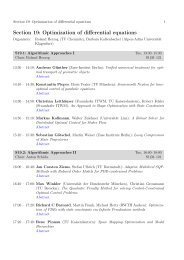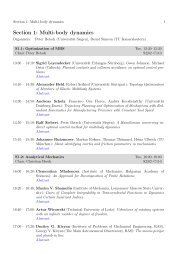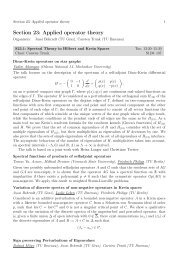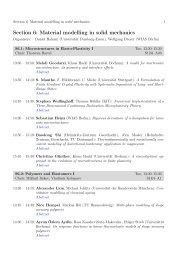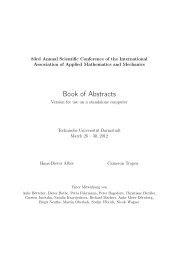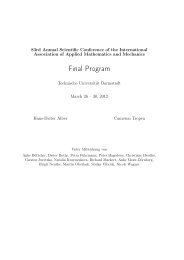Section 6: Material modelling in solid mechanics - GAMM 2012
Section 6: Material modelling in solid mechanics - GAMM 2012
Section 6: Material modelling in solid mechanics - GAMM 2012
Create successful ePaper yourself
Turn your PDF publications into a flip-book with our unique Google optimized e-Paper software.
18 <strong>Section</strong> 6: <strong>Material</strong> <strong>modell<strong>in</strong>g</strong> <strong>in</strong> <strong>solid</strong> <strong>mechanics</strong><br />
Phase separation phenomena <strong>in</strong> alloys, such as sp<strong>in</strong>odal decomposition and Ostwald ripen<strong>in</strong>g<br />
can be described by phasefield models of Cahn-Hilliard-type. Realistic models based on thermodynamically<br />
correct logarithmic free energies conta<strong>in</strong> highly nonl<strong>in</strong>ear and s<strong>in</strong>gular terms as<br />
well as drastically vary<strong>in</strong>g length scales (cf. [1]). We present a globally convergent nonsmooth<br />
Schur-Newton Multigrid method for vector-valued Cahn-Hilliard-type equations ([2, 3]) and a<br />
numerical study of coarsen<strong>in</strong>g <strong>in</strong> a b<strong>in</strong>ary eutectic AgCu alloy tak<strong>in</strong>g <strong>in</strong>to account elastic effects.<br />
Vector-valued Cahn-Hilliard computations open the perspective to multicomponent simulations.<br />
[1] W. Dreyer, W.H. Müller, F. Duderstadt and T. Böhme, “Higher Gradient Theory of Mixtures”,<br />
WIAS-Prepr<strong>in</strong>t No 1286 (2008)<br />
[2] C. Gräser and R. Kornhuber, “Nonsmooth Newton Methods for Set-valued Saddle Po<strong>in</strong>t<br />
Problems”, SIAM J. Numer. Anal. (2009) 47 (2)<br />
[3] C. Gräser, R. Kornhuber, “Schur-Newton Multigrid Methods for Vector-Valued Cahn–Hilliard<br />
Equations”, <strong>in</strong> prep<br />
A Phase Field Model for Martensitc Transformations<br />
Reg<strong>in</strong>a Schmitt, Ralf Müller, Charlotte Kuhn (TU Kaiserslautern)<br />
Consider<strong>in</strong>g the microscopic level of steel, there are different structures with different mechanical<br />
properties. Under mechanical deformation the metastable austenitic face-centered cubic phase<br />
transforms <strong>in</strong>to the tetragonal martensitic phase at which transformation <strong>in</strong>duced eigenstra<strong>in</strong><br />
arises. On the other hand, the mircostructure affects the macroscopic mechanical behavior of<br />
the specimen. In order to take the complex <strong>in</strong>teractions <strong>in</strong>to account, a phase field model for<br />
martensitic transformation is developed. With<strong>in</strong> the phase field approach, an order parameter<br />
is <strong>in</strong>troduced to <strong>in</strong>dicate different material phases. Its time derivative is assumed to follow the<br />
time-dependent G<strong>in</strong>zburg-Landau equation. The coupled field equations are solved us<strong>in</strong>g f<strong>in</strong>ite<br />
elements together with an implicit time <strong>in</strong>tegration scheme. With the aid of this model, the effects<br />
of the elastic stra<strong>in</strong> m<strong>in</strong>imization on the formation of microstructure can be studied so that the<br />
evolution of the martensitic phase is predictable. The applicability of the model is illustrated<br />
through different numerical examples.<br />
Investigation of the stra<strong>in</strong> localization behavior with application of the phase transition<br />
approach<br />
M. Ievdokymov, H. Altenbach, V.A. Eremeyev (Universität Magdeburg)<br />
Metal foams found recently many applications <strong>in</strong> civil, airspace and mechanical eng<strong>in</strong>eer<strong>in</strong>g. In<br />
particular, foams have a good energy absorption property. This property relates to the phenomenon<br />
of localization of stra<strong>in</strong>s <strong>in</strong> foams under load<strong>in</strong>g. In porous materials the localization of<br />
stra<strong>in</strong>s leads to change of mass density of material and appearance of areas with low and high<br />
densities separated by sharp <strong>in</strong>terface. This behavior is similar to the phase transitions <strong>in</strong> <strong>solid</strong>s<br />
with sharp <strong>in</strong>terfaces.<br />
In this paper we use the methods of <strong>modell<strong>in</strong>g</strong> of phase transitions <strong>in</strong> <strong>solid</strong>s to the description of<br />
stra<strong>in</strong> localization <strong>in</strong> foams. We assume that the foam consist of two phases with different densities<br />
and mechanical properties. The results of <strong>modell<strong>in</strong>g</strong> of one- and two-dimensional problems are<br />
discussed. The calculations are performed by Abaqus and script language Python.<br />
S6.8: Elasticity, Viscoelasticity, -plasticity II Wed, 16:00–18:00<br />
Chair: Ismail Caylak S1|01–A1



